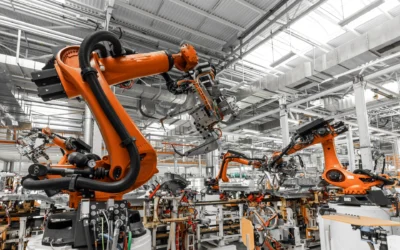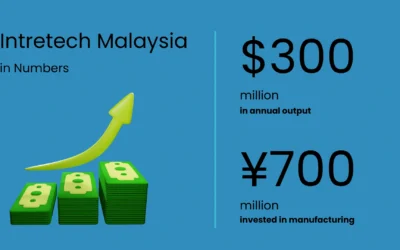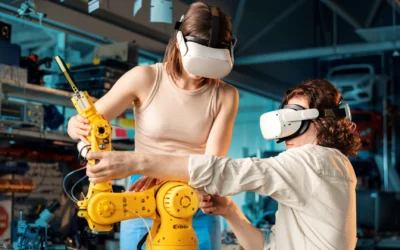12 reasons why Microfactories are the future of manufacturing
Microfactories: The Future
A few days ago, Peter Goodman published a piece in The New York Times, questioning if we will ever have a “normal supply chain” again:
With the havoc at ports showing no signs of abating and prices for a vast array of goods still rising, the world is absorbing a troubling realization: Time alone will not solve the Great Supply Chain Disruption.
With consumers expecting products ever more customised to their tastes, the awareness that we now have of the fragility of our global supply chain and the pressing need to deal with global warming, the perfect storm is upon us to accelerate the adoption of a better manufacturing, through microfactories:
At a very basic level, they are broken down into modules or cells, that each perform a series of assembly actions like gluing, screwing or component placement. They are linked together by a common conveyor and feeder system, providing high volume, high mix production capability.
Image Source: The Visual Capitalist.
Microfactories are the perfect platform to train and upskill engineers and operators. As products get re-shored, so will thousands of jobs. Automation through microfactories becomes an enabler for creating new jobs that are safer, and more fulfilling, where humans can work alongside robots.
Microfactories are ideal for high volume/high Mix
1/12
- Modular automation can scale up or down easily. Depending on the complexity of the product or sub-assembly, manufacturers can easily expect to get 3-4k units’ per hour (UPH), or 1 million units a month. Even if the volume is higher, then the modular Microfactory line can be replicated, with the added benefits of the economies of scale.
- With consumers expecting more personalisation of their products (memory, colours, screen size etc), modular manufacturing gives producers the flexibility to cater to their taste. It’s a perfect fit to produce multiple SKU’s.
Microfactories are more sustainable and have lower carbon footprint
2/12
Mass production lines whether manual or fully automated use large amounts of power to operate. Microfactories use less power than traditional production lines. They are more efficient to create, transport, deploy and operate. As a result, lowering the overall carbon footprint of mass production.
- 70% of each module is the same, it means the module can be reproduced in batches.
- Multiple modules connected to form a production line, is more power efficient than setting up a manual line or fully automated line.
- Most importantly, modules can be re-purposed if the line changes (process), or line becomes obsolete. When a product does not meet sales or quality expectations, the lines that produce them are stopped and often discarded and not recycled in any way, wasting millions in CAPEX investment. Microfactory modules are easily re-furbished and reused if there are unplanned changes.
Microfactories are more cost effective.
3/12
Fully automated lines tend to be highly customised to meet the specific needs of the assembly. When the product requires changes (design changes, quality improvements), then it costs a significant amount of money and efforts to update the line. Very often the demand drops, dropping the capacity of the line, increasing product cost.
With a modular approach the process flow is broken up with each module performing 1-3 processes. If these processes change or are removed, then it is much quicker and lower cost impact, to update the module, or replace with another.
Microfactories have a faster ROI
4/12
A Microfactory costs 25-50% less than a traditional or fully custom automated line. This is because modules use 70% of the same components (frame, power, safety, conveyor system), meaning that you benefit from producing multiple modules at the same time.
Development and assembly time is typically 50% less than a fully automated custom line, meaning you can get to market faster, leveraging first mover advantage. These combine to get an average of 9-12 months return on investment, and lower break-even volumes.
Microfactories enable ultra-fast changeover of product lines
5/12
As products and services become more consumer centric, is critical that manufacturing lines are flexible enough to cater to consumer’s tastes. Microfactories can switch over from one product variant to another in less than 10 minutes. Parts enter the system through a feeder module, when the line needs to start producing a new variant, is a simple as switching the feeder and the Microfactory knows what to do next.
The use of AI camera systems can detect the changes and adjust the control/assembly software to change the assembly process, (for example, assembling 4 screws instead of 6).
Microfactories allow you to manufacture closer to your key markets
6/12
Microfactories = Scalability
7/12
Running low volumes is always a challenge, when setting up traditional production lines. Microfactories allow manufacturers to focus on the bottlenecks or most complex parts of the assembly. When your business grows or gets investment, it can be scaled up at your pace, one module at a time. Showing investors your product is designed for automation, shows that you have a clear roadmap with scale in mind.
With Microfactories you will have less downtime and higher repairability.
8/12
With custom automation lines, manufacturers often require custom parts or sub-assemblies like linear drives and motors. These are often sourced from Japan, Germany/Switzerland and typically have 3-6 months lead-time. Microfactories are modular, containing 70% of standardised components, this makes managing long lead items, easier for the business while reducing the impact of downtime.
Microfactories reduce your shipping and unit costs.
9/12
The cost of shipping from China has gone up in the last few years. A 20ft container went from costing $2,000 to $25000, These costs are directly passed on to the customer. Microfactories can be deployed next to key markets or regions, reducing drastically your shipping costs.
Microfactories reduce your shipping and unit costs.
10/12
There is a very common misconception that robots are taking human jobs. In fact, the opposite is true. Robots are very successful at completing repetitive tasks they’ve been programmed to complete. Customisation, creativity, and personalisation remain in the realm of humans. While many jobs will shift to robots, new jobs are created that require human intervention. Ty Brady from Amazon, succinctly presents it: “The challenge that we have in front of us is how do we smartly design our machines to extend human capability.”
There is also the plain fact that factories and businesses are finding it hard to recruit and keep operators to perform repetitive tasks. Industry 4.0 brought the age of digital manufacturing, but it ‘robotises’ humans, where in fact it is better that humans and robots work together, which is the direction Industry 5.0 is moving towards.
Microfactories excel at high precision and repetitiveness.
11/12
Microfactories are perfect for products where there is repetition of tasks that need high precision at high volumes. They are suited for consumer electronics, medical sectors, and sub-assemblies for larger end-products, like automotive. On average 80% of tasks to build these products can be done within a Microfactory using applications like screwing, gluing, pick and place etc.
Ongoing advances in control software, AI for camera vision and custom electronic measurements to control quality, means that Microfactories are future-proof.
Microfactories: A new way to think about your CAPEX
12/12
When talking abut CAPEX, Microfactories open opportunities for disruptive business models in manufacturing. Traditionally custom lines involve heavy investment with 2-3 years ROI. As the micro-factory is made of modules or cells, it is possible to allow for a model to rent and return after mass production for refurbishment and repurposing, meaning smaller up-front CAPEX investment. This allows new manufacturers to enter the space, creating more jobs and innovation.
Explore more related content
The Innovations that Shaped Manufacturing
The Innovations that Shaped Manufacturing in 2024 Every year, different trends drive every industry, and manufacturing...
Intretech Shines at PMI Supplier Summit: A Collaborative Vision for Excellence
Intretech Shines at PMI Supplier Summit: A Collaborative Vision for ExcellenceIntretech Ltd, a forerunner in the...
How is Generative AI Shaping the Future of Manufacturing Design and Prototyping?
How is Generative AI Shaping the Future of Manufacturing Design and Prototyping?The use of artificial intelligence...














